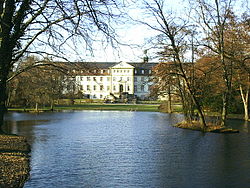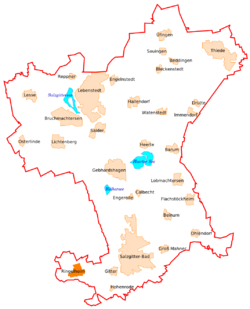Sights
The most important attraction is Schloss Ringelheim, the former abbey founded in the tenth century and secularised in 1803. The large park (Schlosspark) with a serpentine lake in the English landscape garden manner was laid out in 1847 for Count Adolf von der Decken. Close to it there are the sport grounds and the River Innerste. The Baroque church of St. Abdon und Sennen built in 1694 is known for its precious organ and the crucifix from the workshop of Prince-bishop Bernward of Hildesheim.
Ringelheim has some shopping facilities (supermarket, drug-store, retail), restaurants, banks, doctor, dentist, pharmacy, an alcohol detox clinic and an institution for handicapped persons.

Salzgitter is an independent city in southeast Lower Saxony, Germany, located between Hildesheim and Braunschweig. Together with Wolfsburg and Braunschweig, Salzgitter is one of the seven Oberzentren of Lower Saxony. With 101,079 inhabitants and 223.92 square kilometres (86.46 sq mi), its area is the largest in Lower Saxony and one of the largest in Germany. Salzgitter originated as a conglomeration of several small towns and villages, and is today made up of 31 boroughs, which are relatively compact conurbations with wide stretches of open country between them. The main shopping street of the young city is in the borough of Lebenstedt, and the central business district is in the borough of Salzgitter-Bad. The city is connected to the Mittellandkanal and the Elbe Lateral Canal by a distributary. The nearest metropolises are Braunschweig, about 23 kilometres to the northeast, and Hanover, about 51 km to the northwest. The population of the City of Salzgitter has exceeded 100,000 inhabitants since its foundation in 1942, when it was still called Watenstedt-Salzgitter. Beside Wolfsburg, Leverkusen and Eisenhüttenstadt, Salzgitter is one of the few cities in Germany founded during the 20th century.

The Principality of Calenberg was a dynastic division of the Welf duchy of Brunswick-Lüneburg established in 1432. Calenberg was ruled by the House of Hanover from 1635 onwards; the princes received the ninth electoral dignity of the Holy Roman Empire in 1692. Their territory became the nucleus of the Electorate of Hanover, ruled in personal union with the Kingdom of Great Britain from 1714 onwards. The principality received its name from Calenberg Castle, a residence of the Brunswick dukes.

Hornburg is a town and a former municipality in the Wolfenbüttel district, in the German state of Lower Saxony. Since 1st November 2013, it is a part of the municipality Schladen-Werla. It is situated at the Ilse river, a tributary of the Oker. Hornburg is part of the Samtgemeinde Schladen and home to numerous historically valuable half-timber buildings (Fachwerkhäuser). It is located on the German Timber-Frame Road.

The Diocese of Halberstadt was a Roman Catholic diocese from 804 until 1648. From 1180, the bishops or administrators of Halberstadt ruled a state within the Holy Roman Empire, the prince-bishopric of Halberstadt. The diocesan seat and secular capital was Halberstadt in present-day Saxony-Anhalt.
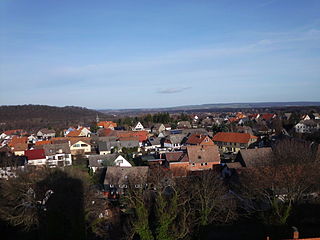
Vienenburg is a borough of Goslar, capital of the Goslar district, in Lower Saxony, Germany. The former independent municipality was incorporated in Goslar on 1 January 2014.

Liebenburg is a municipality in the district of Goslar, in Lower Saxony, Germany.

The Prince-Bishopric of Münster was a large ecclesiastical principality in the Holy Roman Empire, located in the northern part of today's North Rhine-Westphalia and western Lower Saxony. From the sixteenth to the eighteenth centuries, it was often held in personal union with one or more of the nearby ecclesiastical principalities of Cologne, Paderborn, Osnabrück, Hildesheim, and Liège.

Henry V of Brunswick-Wolfenbüttel, called the Younger,, a member of the House of Welf, was Duke of Brunswick-Lüneburg and ruling Prince of Brunswick-Wolfenbüttel from 1514 until his death. The last Catholic of the Welf princes, he was known for the large number of wars in which he was involved and for the long-standing affair with his mistress Eva von Trott.

The Prince-Bishopric of Minden was an ecclesiastical principality of the Holy Roman Empire. It was progressively secularized following the Protestant Reformation when it came under the rule of Protestant rulers, and by the Peace of Westphalia of 1648 given to Brandenburg as the Principality of Minden. It must not be confused with the Roman Catholic diocese of Minden, which was larger, and over which the prince-bishop exercised spiritual authority.
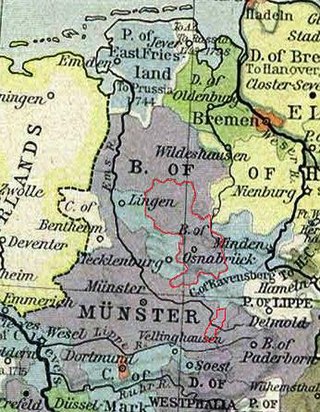
The Prince-Bishopric of Osnabrück) was an ecclesiastical principality of the Holy Roman Empire from 1225 until 1803. It should not be confused with the Diocese of Osnabrück, which was larger and over which the prince-bishop exercised only the spiritual authority of an ordinary bishop. It was named after its capital, Osnabrück.

Dorstadt is a municipality in the district of Wolfenbüttel, in Lower Saxony, Germany. It is part of the Samtgemeinde Oderwald.

The Prince-Bishopric of Paderborn was an ecclesiastical principality (Hochstift) of the Holy Roman Empire from 1281 to 1802.
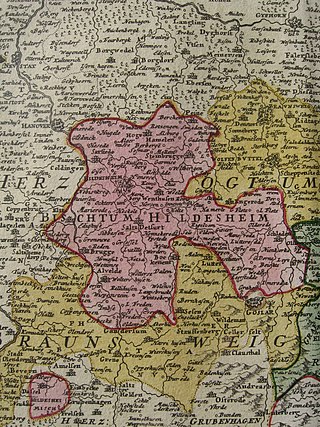
The Prince-Bishopric of Hildesheim was an ecclesiastical principality of the Holy Roman Empire from the Middle Ages until its dissolution in 1803. The Prince-Bishopric must not be confused with the Diocese of Hildesheim, which was larger and over which the prince-bishop exercised only the spiritual authority of an ordinary bishop.

The Hildesheim Diocesan Feud or Great Diocesan Feud, sometimes referred to as a "chapter feud", was a conflict that broke out in 1519 between the Prince-Bishopric of Hildesheim and the principalities of Brunswick-Wolfenbüttel and Calenberg that were ruled by the House of Welf. Originally just a local conflict between the Hildesheim prince-bishop John IV of Saxe-Lauenburg and his own prince-bishopric's nobility (Stiftsadel), it developed into a major dispute between various Lower Saxon territorial princes. The cause was the attempt by Prince-Bishop John to redeem the pledged estates and their tax revenue from the nobles in his temporalities, the prince-bishopric. The diocesan feud ended with the Treaty of Quedlinburg in 1523.

The Principality of Brunswick-Wolfenbüttel was a subdivision of the Duchy of Brunswick-Lüneburg, whose history was characterised by numerous divisions and reunifications. It had an area of 3,828 square kilometres in the mid 17th century. Various dynastic lines of the House of Welf ruled Brunswick-Wolfenbüttel until the dissolution of the Holy Roman Empire in 1806. As a result of the Congress of Vienna, its successor state, the Duchy of Brunswick, was created in 1815.

Bertold of Landsberg was bishop of Verden. He was also Bishop of Hildesheim as Berthold II.

Henry III of Brunswick-Lüneburg was the ruling Prince-Bishop of Hildesheim from 1331 until his death.

The House of Asseburg, original German name von der Asseburg, is an old Lower Saxon aristocratic family which had its origin in Wolfenbüttel and Asseburg. During the 12th and 13th centuries the lords of Wolfenbüttel were able to establish their own small county, but were soon forced to give way to the Brunswick dukes of the House of Welf. Later their title was taken over by other families in the female line, and the counts of Asseburg continue to be landowners to this day.

The Hildesheim–Goslar railway is a 53 kilometre long, double-track and non-electrified main line in the northern Harz foothills in the German state of Lower Saxony. It serves mainly to connect with the tourist region in the northern Harz with Hildesheim and Hanover. It is served by the HarzExpress, running between Halle, Halberstadt, Goslar and Hannover Hauptbahnhof. The most important station and junction of the line is Salzgitter-Ringelheim station.
